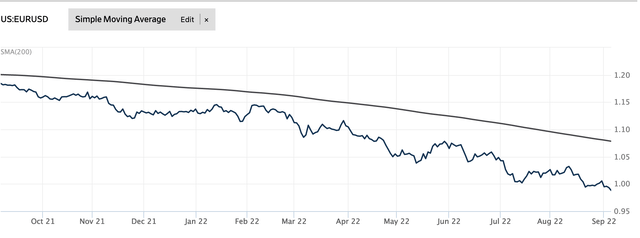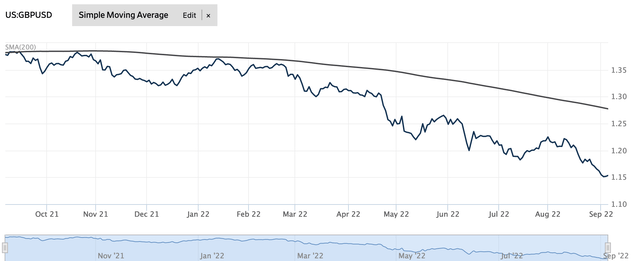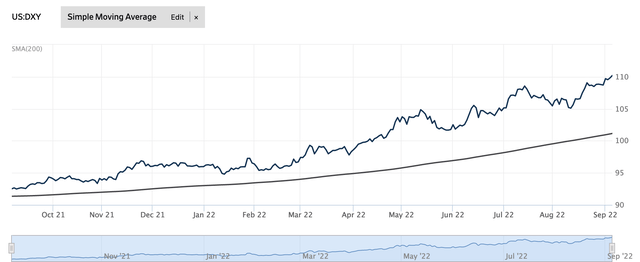Talaj
The value of the U.S. dollar continues to climb.
Against the Euro, the cost of one Euro has dropped below $0.99.
U.S. dollar/Euro exchange rate (Wall Street Journal)
The decline in the value of the British Pound relative to the U.S. dollar is about the same.
U.S. Dollar/British pound exchange rate (Wall Street Journal )
The price of the pound dropped down to trade around $1.1450.
This is the lowest price of the pound since 1985.
And, things do not seem to promise anything better for the near term.
In fact, there are some experts that are saying that it won’t be long before the British pound, like the Euro, will hit parity.
The State Of The World
Many look at the condition of the United States economy and argue that things do not look that good for the economy’s future.
But, then one looks at the exchange rates, like the ones posted above and one begins to think that, relative to a lot of other areas in the world, like Europe and England, maybe things in the United States do not look that bad.
The relative value of the currencies tells an important story.
Yes, the U.S. economy may not be doing all that well, but look at the state of other economies.
The United States faces inflation rates of around 7.0 percent and 8.0 percent.
Europe is not facing inflation rates at double-digit levels.
And, there are some experts that are saying that inflation in England could hit 22.0 percent next year.
What’s Driving This?
Well, there is a lot driving this.
There is the situation in Ukraine driving this.
There is the energy situation in the world driving this.
There are the supply chain problems coming out of the Covid-19 situation driving this.
There are “bad” government decisions driving this.
And, there is a massive amount of money floating around the world driving this.
In fact, the world has never been in such a position where so much money is chasing so few goods.
Thank you, central banks.
Now, people are reacting against some of these things.
And, governments are starting to react against some of these things.
Of course, governments reacting against some of these things is only causing the situation to get worse.
This is where the fighting of inflation comes into the picture.
Different countries and different geographic areas around the world are getting started in a global effort to lessen inflation, but none of the central banks entering the fight are in sync.
In the United States the Federal Reserve, this year, has really started to combat inflation. And, although that is another story in itself, the Federal Reserve seems to be ahead of other countries in their fight against inflation.
The ironic part of this is that so many people are criticizing the Fed for “being behind the curve” in its fight against inflation, the fact is that the Federal Reserve is ahead of almost everybody else in this struggle.
And, this is why exchange rates have become so volatile.
Dollar Strong
And, the bottom line is, that the strong U.S. dollar has become just that much stronger as the world’s primary reserve currency.
Just look at the charts.
U.S. Dollar Index (DXY) (Wall Street Journal)
The index began the year 96.0.
Tuesday morning, September 6, 2022, the index was over 110.0, a rise of almost 15.0 percent.
And, projections, as mentioned above, indicate that the dollar will continue to rise into 2023.
The basic reason behind this view is that the Federal Reserve will continue to lead other central banks in fighting inflation. Most analysts now are predicting that the Fed will continue to raise its policy rate of interest well into 2023 and will go even beyond that in reducing the size of its securities portfolio.
How this is going to impact, not only the developed economies of the world but also how this will affect the emerging economies, is unknown.
The concern is that the world could move into a global recession accompanied by prices that are rising faster than anyone really wants.
Traders seem to be telling us that, relative to the United States, other countries and geographic areas are not expected to do very well in the near future.
But, traders also seem to be telling us that the United States is not expected to do very well in the near future, either.
So, what does that tell us about the future economic performance of the world?


Be the first to comment